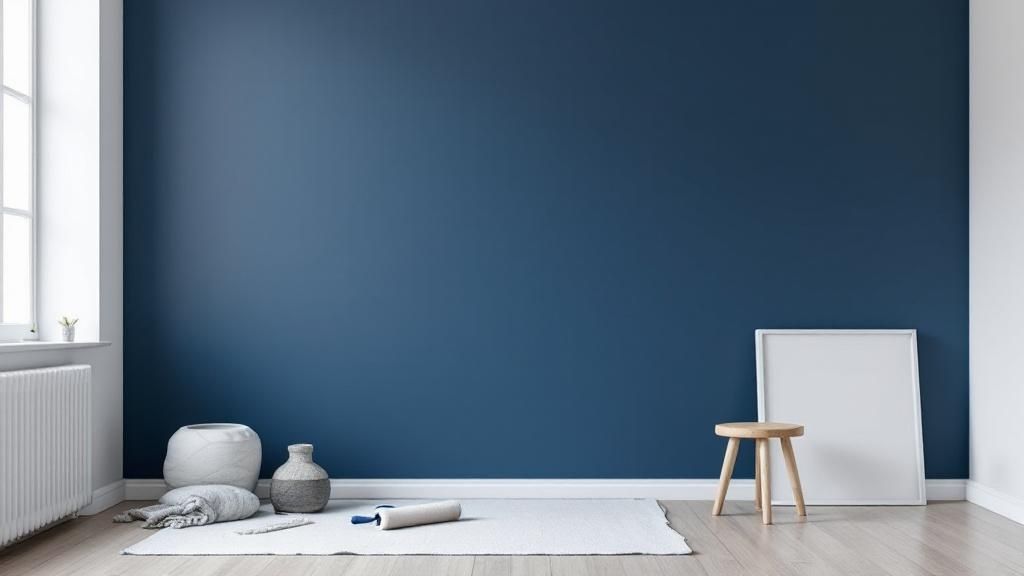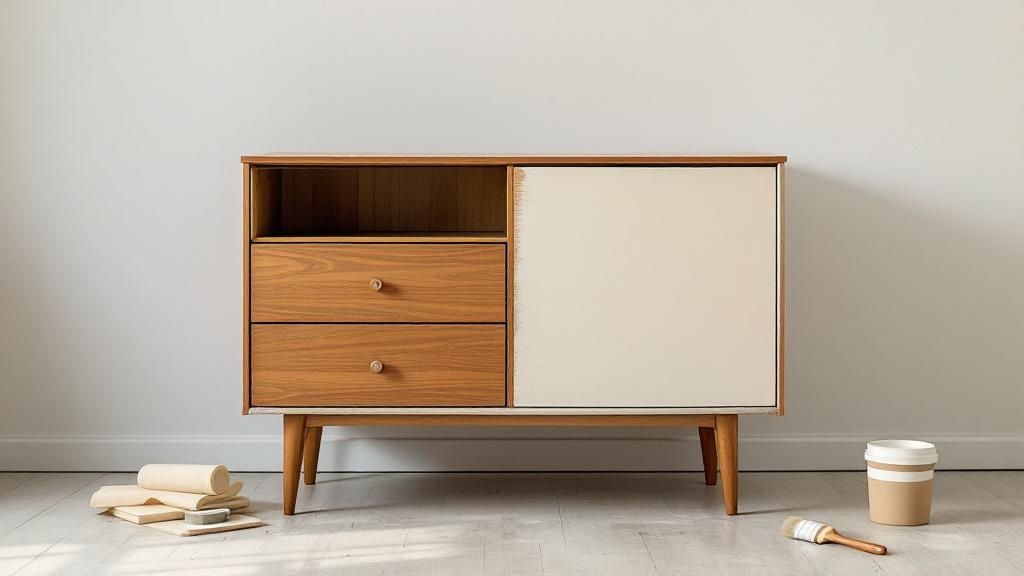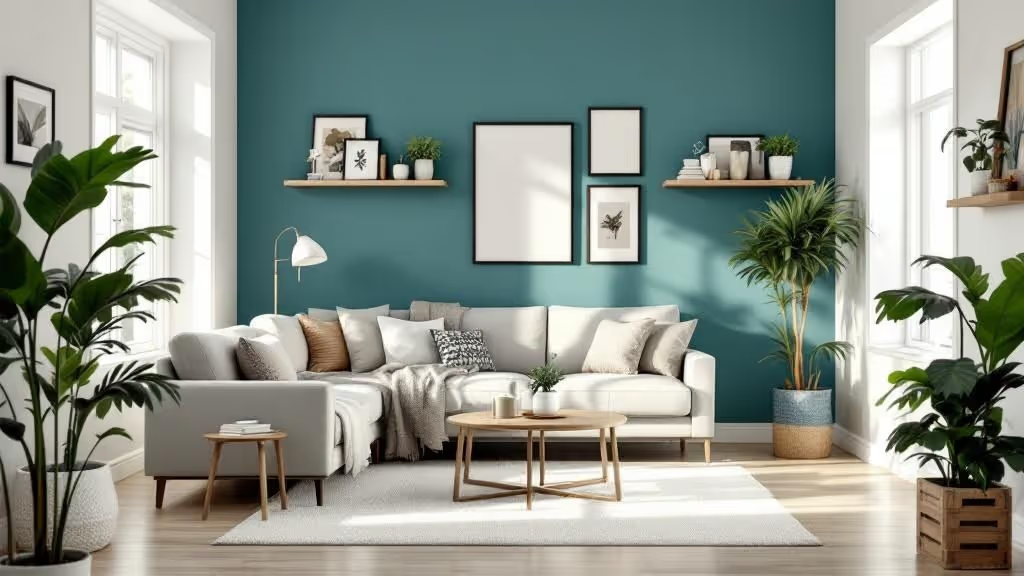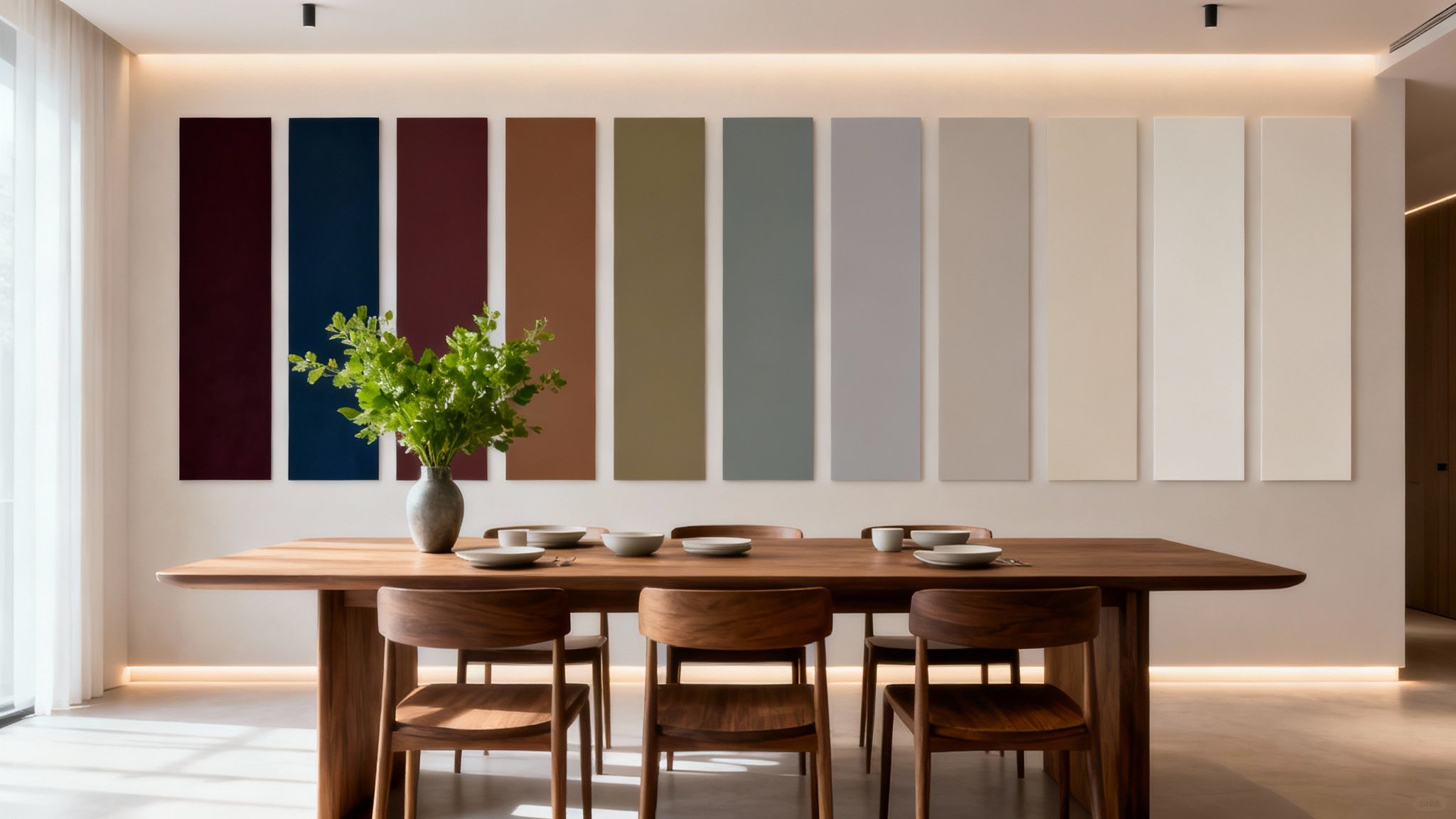Creating a home that looks like it's straight from a design magazine doesn't have to come with a premium price tag. The secret lies in strategic choices, a touch of creativity, and knowing exactly where to invest for maximum visual impact. This guide is your ultimate resource for affordable interior design, offering a comprehensive roundup of actionable ideas that deliver transformative results without demanding a significant financial outlay.
We will explore eight powerful techniques that professional designers use to elevate a space on a budget. You will learn how to harness the transformative power of a simple tin of paint, master the art of thrift store furniture flipping, and strategically update lighting to completely alter a room's atmosphere. We will also delve into creating stunning gallery walls, using textiles to introduce colour and texture, and implementing clever storage that is both stylish and practical. Forget the misconception that beautiful interiors are reserved for those with deep pockets; we're here to show you how to cultivate a chic, personalised, and inviting space that reflects your taste without emptying your wallet.
This is not a list of vague suggestions. Each concept is broken down into practical steps, real-world examples, and specific implementation tips, empowering you to refresh your living space with confidence and flair. Whether you're tackling a full room makeover or looking for a quick weekend project, these insights will help you achieve a high-end look for less. Let's delve into the art of making your home look expensive, affordably.
1. Paint as a Room Transformer
Of all the tools in the arsenal of affordable interior design, paint offers the most dramatic impact for the least amount of money. A few tins of paint and a weekend of effort can completely redefine a space, altering its mood, perceived size, and overall style without the need for any structural changes or expensive new furnishings. It is the ultimate high-impact, low-cost solution for a home refresh.

This method goes far beyond simply painting four walls in a single shade. Strategic use of colour can solve common design problems and inject personality into otherwise bland rooms. By understanding a few key techniques, you can wield a paintbrush like a designer's magic wand.
Creative Painting Techniques
- Accent Walls: The classic approach. Painting a single wall in a bold or contrasting colour creates an instant focal point. A deep navy blue or forest green wall behind a headboard can add a touch of sophistication to a neutral bedroom.
- Colour Drenching: For a bold, contemporary look, paint the walls, skirting boards, window frames, and even the ceiling in the same colour. This immersive technique can make a room feel incredibly cosy and deliberate.
- Two-Tone Walls: Painting the bottom half of a wall a different colour from the top half (a modern take on a dado rail) can add architectural interest. This works wonderfully in hallways and dining rooms.
- Painted Furniture: Give a tired chest of drawers or a dated kitchen cabinet a new lease of life with a coat of chalk paint. Painting upper and lower kitchen cabinets in different colours (e.g., light uppers, dark lowers) is a popular trend that adds depth and style.
Key Insight: The true power of paint lies in its versatility. It can be used to highlight architectural features you love or cleverly disguise those you don’t.
Practical Tips for a Professional Finish
To ensure your efforts look polished, follow these simple guidelines. First, always test your chosen paint colours. Paint a small patch on the wall and observe how it looks in natural and artificial light throughout the day. Secondly, invest in quality tools; good brushes and rollers prevent streaks and provide better coverage. Finally, consider the paint’s finish. A durable, semi-gloss or satin finish is ideal for high-traffic areas like kitchens and hallways, while a matt finish provides a soft, modern look for bedrooms and living rooms.
2. Thrift Store and Secondhand Furniture Flipping
Tapping into the world of pre-loved items is a cornerstone of affordable interior design, allowing you to acquire unique, high-quality pieces for a fraction of their retail price. The practice involves finding furniture at charity shops, estate sales, or online marketplaces and transforming them through restoration or creative updates. This sustainable approach not only saves money but also results in one-of-a-kind furniture that infuses your home with character and stories.

This method empowers you to look past surface-level imperfections and see the potential within a dated or worn-out piece. With a bit of vision and elbow grease, a forgotten relic can become the standout feature of a room. This process, championed by figures like Joanna Gaines and a vibrant community of DIY influencers, turns decorating into a creative and rewarding pursuit.
Creative Flipping Ideas
- Modern Restoration: A mid-century dresser with great lines but a tired finish can be sanded down and given a fresh coat of paint or a contemporary stain. New hardware, such as brass knobs or leather pulls, can complete the modern transformation.
- Fabric Revival: An old armchair with a sturdy frame but dated fabric is a prime candidate for reupholstering. Choosing a bold, contemporary pattern can turn it into a statement piece that perfectly matches your colour scheme.
- Creative Repurposing: Think outside the box. An old wooden ladder can be mounted horizontally to create a unique bookshelf, or a vintage suitcase can be fitted with legs to serve as a quirky side table.
- Two-Tone Finish: Give a plain chest of drawers or a sideboard a designer touch by painting the frame one colour and leaving the drawer fronts in their natural wood finish, or vice-versa.
Key Insight: The most valuable finds often have "good bones." Prioritise solid wood construction and structural integrity over cosmetic appearance, as surfaces can always be changed.
Practical Tips for a Successful Flip
To ensure your secondhand finds turn into treasures, a strategic approach is key. Before buying, thoroughly inspect the item for stability, signs of woodworm, or serious damage that might be beyond a simple fix. Secondly, do a little research on the spot; a quick search on your phone can reveal if a piece is from a notable brand or era, making it a particularly valuable find. Finally, start with simple projects, like sanding and painting a small table, to build your skills and confidence before tackling more complex tasks like reupholstery. You can find inspiration and more ideas by exploring budget-friendly home swaps that make a big impact.
3. Strategic Lighting Updates
Often overlooked in favour of furniture or colour, lighting is one of the most powerful and transformative elements in interior design. Strategic updates to your lighting scheme can fundamentally alter a room's mood, highlight its best features, and improve its functionality, all without the need for expensive rewiring. It's a cornerstone of affordable interior design that delivers a professional and considered feel for a minimal investment.

The secret is to move beyond the single, central ceiling fixture and think in layers. By combining different types of light sources, you can create a versatile and inviting atmosphere that adapts to any occasion, from a brightly lit workspace to a cosy evening retreat. This layered approach adds depth and sophistication to any space.
Creative Lighting Solutions
- Plug-In Pendants & Wall Lights: These offer the high-end look of professionally installed fixtures without the electrician. Hang a plug-in pendant light over a bedside table or in a reading nook to create a stylish focal point.
- LED Strip Lighting: Incredibly versatile and discreet, LED strips are perfect for adding functional and atmospheric light. Place them under kitchen cabinets to illuminate countertops, behind a TV for a soft glow, or along the top of bookshelves to highlight your collection.
- Statement Lamps: A large arc floor lamp can elegantly extend over a sofa, providing task lighting for reading without taking up floor space. Similarly, a pair of sculptural table lamps on a console table adds symmetry and warm, ambient light to an entryway.
- Atmospheric String Lights: No longer just for Christmas or student rooms, delicate fairy or festoon lights can add a magical, whimsical touch. Drape them around a headboard, frame a mirror, or place them inside a large glass vase for a unique accent.
Key Insight: A well-lit room layers three types of lighting: ambient (overall illumination), task (for specific activities like reading), and accent (to highlight features).
Practical Tips for a Polished Glow
To make your lighting choices work effectively, focus on the details. Always choose warm white bulbs (around 2700K-3000K) for living rooms and bedrooms to create a cosy, inviting atmosphere; cooler whites are better suited for kitchens and bathrooms. Where possible, use dimmer-compatible bulbs and switches to give you complete control over the room's brightness and mood. Finally, manage your cables. Neatly hide cords by running them along skirting boards, behind furniture, or using decorative cable trunking for a clean, professional finish.
4. Plant-Based Natural Decor
Embracing nature is one of the most effective and affordable interior design strategies for breathing life and tranquillity into a home. This biophilic approach involves more than just placing a pot plant on a windowsill; it's about integrating living greenery, dried botanicals, and natural textures like wood and stone to create a space that feels calm, connected, and vibrant. This method brings the outdoors in, improving air quality and boosting your mood for minimal cost.

The beauty of this trend is its scalability. You can start with a single, sculptural snake plant or fully commit to an "urban jungle" aesthetic. Natural elements add texture, colour, and a sense of organic movement that softens hard lines and makes a room feel more welcoming and lived-in.
Creative Ways to Incorporate Nature
- Statement Plants: Use large floor plants, like a fiddle-leaf fig or a monstera, in stylish planters to anchor a corner of a living room or bedroom. They act as living sculptures, creating a dramatic focal point.
- Hanging Gardens: Trailing plants like pothos or string of pearls look stunning in macrame hangers. Suspending them from the ceiling draws the eye upward, making a room feel taller and more dynamic.
- Botanical Displays: Create a gallery wall using pressed botanical prints for a sophisticated, artistic touch. You can also arrange dried flowers, pampas grass, or eucalyptus branches in vases for long-lasting, low-maintenance beauty.
- Functional Greenery: Cultivate a small herb garden on a sunny kitchen windowsill. It not only looks charming but also provides fresh ingredients for your cooking, blending decor with practicality.
Key Insight: Natural decor connects your living space to the outdoors, promoting a sense of well-being and calm that is difficult to replicate with manufactured items.
Practical Tips for a Thriving Indoor Garden
To ensure your plant decor flourishes, a little planning goes a long way. First, start with low-maintenance "beginner" plants like snake plants, ZZ plants, or pothos, which are very forgiving. Second, group plants with similar needs; placing humidity-loving ferns together makes watering and care much simpler. Finally, always research which plants are pet-safe if you have furry friends at home. The latest garden trends also offer great inspiration; learn more about bringing the best of the outdoors inside for the coming year.
5. Gallery Wall Creation
A gallery wall is one of the most personal and impactful forms of affordable interior design, transforming a blank wall into a curated story of your life and style. It involves arranging a collection of artwork, photographs, and even three-dimensional objects to create a single, cohesive visual statement. This technique allows you to fill a large space without a large budget, using a mix of inexpensive prints, personal photos, and thrifted frames to make a home feel truly unique.
This method moves beyond hanging a single piece of art, allowing for endless creativity and evolution. A well-designed gallery wall can introduce colour, texture, and personality into a room, serving as a focal point in a living room, hallway, or above a bed. It’s a dynamic feature that you can add to over time, making it a design project that grows with you.
Creative Gallery Wall Ideas
- Eclectic & Personal: Combine family photos in various mismatched vintage frames with children's drawings, postcards, and small mementos. This style is all about personality and warmth.
- Monochromatic & Modern: For a sleek, sophisticated look, stick to a strict colour palette. A collection of black and white photography in matching black or white frames creates a powerful, unified display.
- Themed Collections: Build your gallery around a central theme. This could be botanical prints, abstract art, travel memorabilia featuring maps and tickets, or even a collection of small mirrors to bounce light around the room.
- Grid Layout: For a more formal and organised appearance, hang identical-sized frames in a precise grid. This approach works well in minimalist or contemporary spaces and gives a clean, high-end feel.
Key Insight: A successful gallery wall isn't just about what you hang; it's about the negative space between the items. Consistent spacing is the secret to making a varied collection look deliberate and polished.
Practical Tips for a Flawless Layout
To avoid a chaotic look and unnecessary nail holes, careful planning is essential. First, arrange your entire collection on the floor to finalise the layout before you pick up a hammer. Second, create paper templates for each frame; cut out paper shapes matching the size of each piece and tape them to the wall with masking tape to test the arrangement visually. Finally, when mixing frame styles and sizes, try to maintain a consistent spacing of 5-8 cm between each item to ensure the overall composition feels balanced and intentional.
6. Textile and Fabric Transformation
If you are looking for an immediate and impactful change without long-term commitment, textiles are your greatest ally in the world of affordable interior design. The strategic use of fabrics like curtains, rugs, cushions, and throws can completely alter a room's atmosphere, introducing new colours, patterns, and textures. This approach allows you to inject personality and comfort into a space instantly.
This method is about more than just adding a few cushions to a sofa; it is about layering. By combining different materials and patterns, you can build a rich, inviting, and visually interesting environment. It’s an incredibly flexible technique, allowing for easy updates as seasons or your tastes change.
Creative Fabric Techniques
- Layered Rugs: Place a smaller, patterned, or textured rug (like a faux sheepskin or jute) on top of a larger, neutral one. This adds depth, defines a specific zone like a seating area, and introduces warmth.
- Cushion Curation: Transform a plain sofa or armchair by mixing and matching cushions. Combine different sizes, shapes (square, lumbar), and textures (velvet, linen, bouclé) to create a cosy and stylish arrangement.
- Strategic Throws: A well-draped throw blanket on a bed, chair, or the arm of a sofa adds a touch of casual elegance and an inviting feel. Choose a material that complements the season, such as chunky knit wool for winter or lightweight cotton for summer.
- Curtain Elevation: Hang curtains high and wide, extending the rod well beyond the window frame. This simple trick makes windows appear larger and ceilings taller, lending a more spacious and polished feel to the room.
Key Insight: Fabrics are the easiest way to experiment with trends. A few bold, patterned cushions are a much lower-risk investment than a brightly coloured sofa.
Practical Tips for a Cohesive Look
To ensure your fabric choices create a harmonious design rather than a cluttered mess, follow a few core principles. First, use the 60-30-10 rule: 60% of the room should be a dominant colour (walls), 30% a secondary colour (furniture), and 10% an accent colour (textiles). This creates a balanced palette. Secondly, don't be afraid to mix patterns, but vary their scale. Pair a large-scale floral with a small-scale geometric print to ensure they complement rather than compete. Finally, consider texture as a key element; combining smooth cottons with rough linens and soft velvets creates a tactile richness that makes any space feel more sophisticated.
7. Creative Storage Solutions
Effective storage is the unsung hero of a well-designed home, but it doesn't have to be purely utilitarian or expensive. Creative storage is a cornerstone of affordable interior design, transforming necessary organisation into a key decorative feature. By choosing pieces that are both functional and beautiful, you can declutter your space while actively enhancing its style.
This approach moves beyond hiding things away in plastic boxes and instead integrates storage into your home's aesthetic. The goal is to find solutions that serve a dual purpose, acting as both practical organisers and stylish accents. From multi-functional furniture to artfully arranged shelving, smart storage proves that organisation and decoration can be one and the same.
Innovative Storage Implementations
- Styled Open Shelving: Floating shelves or ladder-style units offer a perfect stage for a curated display. Mix books with decorative objects, small plants, and personal photos to create a vignette that is both practical and full of personality.
- Dual-Purpose Furniture: An ottoman with a removable lid provides hidden storage for blankets and magazines in the living room. Similarly, a bench with built-in cubbies by the entrance can store shoes while offering a place to sit.
- Decorative Baskets & Bins: Woven baskets in materials like rattan or seagrass add texture and warmth to a room. Use them to stylishly conceal everything from children's toys and extra cushions to laundry or firewood.
- Vertical Space Utilisation: In smaller rooms, think upwards. Tall, narrow bookcases or wall-mounted shelving systems draw the eye up, making the room feel more spacious while maximising storage capacity without sacrificing floor space.
Key Insight: The best storage solutions don’t just hide clutter; they contribute to your home’s overall design narrative, adding texture, colour, and character.
Practical Tips for Stylish Organisation
To ensure your storage is both effective and aesthetically pleasing, focus on curation and cohesion. When styling open shelves, use the 'rule of thirds' to create balanced, visually interesting arrangements. Secondly, choose storage that complements your decor; a rustic wooden crate will look at home in a farmhouse-style kitchen, while sleek metallic bins suit a more modern aesthetic. Finally, for closed storage, using uniform, labelled containers creates a sense of calm and makes items easy to find. Exploring curated selections can provide excellent inspiration for finding pieces that fit your style; you can explore beautiful and practical options from lifestyle brands for further ideas.
8. Mirror Magic for Space Enhancement
Mirrors are one of the most powerful and versatile elements in the world of affordable interior design. More than just a tool for checking your reflection, a well-placed mirror can dramatically alter the perception of a room, making it feel larger, brighter, and more open. This clever trick, long used by professional designers, manipulates light and reflection to create an illusion of depth and space where none exists.
The principle is simple: mirrors bounce light around a room and reflect their surroundings, creating visual duplicates that trick the eye. By strategically positioning mirrors of various shapes and styles, you can solve common spatial challenges, such as narrow hallways or dark corners, while simultaneously adding a beautiful decorative feature.
Creative Mirror Placement Techniques
- Reflect Natural Light: The most classic and effective technique. Place a large mirror directly opposite a window to capture and double the amount of natural light flooding into the space. This is particularly effective in north-facing rooms that can often feel gloomy.
- Create a Focal Point: Use a large, oversized, or ornately framed mirror as a standalone piece of art. Positioned above a mantelpiece, a console table in an entryway, or a sideboard in a dining room, it commands attention and adds a sense of grandeur.
- Expand Small Spaces: In a small bedroom, consider mirrored wardrobe doors. They cleverly blend into the room while visually doubling the floor space. Similarly, a long mirror at the end of a narrow hallway creates the illusion of a much longer, more expansive corridor.
- Gallery Wall: For a more eclectic and artistic approach, create a gallery wall using a collection of smaller, decorative mirrors in different shapes and styles. This adds texture, interest, and reflective light without the dominance of a single large piece.
Key Insight: A mirror doesn't just reflect a room; it amplifies it. Use it to bounce light into dark areas and reflect the most attractive views or design elements in your space.
Practical Tips for Maximum Impact
To make the most of your mirrors, consider their placement carefully. Before hanging, have someone hold the mirror in the proposed spot while you observe what it reflects from key vantage points, like the sofa or the doorway. Ensure it reflects something beautiful, such as a piece of art, a view of the garden, or a stylish light fixture, rather than a cluttered corner. Don't be afraid to go big; an oversized floor-standing mirror leaning against a wall adds a relaxed, modern feel and has a huge impact on the sense of space.
Affordable Interior Design: 8 Key Strategies Compared
Your Journey to a Beautifully Designed Home Starts Now
Throughout this guide, we have journeyed through a landscape of creativity, resourcefulness, and clever design, proving that a spectacular home is not a matter of budget, but of vision. The core principle of affordable interior design is about unlocking the hidden potential within your space and your possessions through strategic, high-impact changes. It’s about realising that the most profound transformations often come from the simplest ideas, executed with care and personal flair.
We've dismantled the myth that professional-level results require a professional-level price tag. Instead, we have equipped you with a practical toolkit filled with eight powerful strategies, from the transformative power of a single tin of paint to the space-expanding magic of a well-placed mirror. Each concept is a testament to the idea that style is accessible to everyone.
Recapping Your Path to a Stylish Home
Let's revisit the cornerstones of affordable interior design we've explored:
- The Power of Paint: We saw how colour can single-handedly redefine a room's mood, size, and energy, making it the ultimate budget-friendly tool for dramatic change.
- Secondhand Treasures: Flipping pre-loved furniture isn't just cost-effective; it's a way to infuse your home with unique character and sustainable style that mass-produced items can't replicate.
- Strategic Lighting: By layering ambient, task, and accent lighting, you can craft an atmosphere of warmth and sophistication without needing to rewire your entire home.
- Living Décor: Introducing houseplants is more than an aesthetic choice; it’s a method for purifying your air, adding organic texture, and bringing vibrant life into every corner.
- Personalised Gallery Walls: Your walls are blank canvases. Curating a gallery wall allows you to tell your personal story, turning memories and art into a powerful focal point.
- Textile Transformations: The simple act of swapping out cushions, throws, or curtains can instantly update your colour scheme and add layers of comfort and luxury.
- Creative Storage: We learned that effective storage solutions can be beautiful. By turning clutter into curated displays, you create a sense of calm and organised elegance.
- The Illusion of Space: Mirrors are your secret weapon for making small rooms feel larger, dark corners brighter, and narrow hallways wider.
Your Actionable Next Steps
Feeling inspired is wonderful, but taking action is what turns inspiration into reality. The journey to your dream home doesn't have to be overwhelming. The key is to start small and build momentum.
- Choose ONE Project: Don't try to tackle everything at once. Look back through the list and pick the single idea that excites you the most. Is it creating a gallery wall above your sofa? Or perhaps finding the perfect secondhand sideboard to paint?
- Define Your Scope and Budget: For your chosen project, set a clear goal and a realistic budget. If you're painting, how much will the paint and supplies cost? If you're thrifting, what's your maximum spend?
- Gather Your Tools and Inspiration: Create a mood board on Pinterest or collect magazine clippings. Make a list of everything you need before you begin. Preparation is the key to a smooth and enjoyable process.
- Execute and Enjoy the Process: Remember, interior design is a journey, not a destination. Embrace the creative process, learn from any mistakes, and celebrate your progress along the way.
By mastering these principles of affordable interior design, you are not just saving money; you are investing in your own creativity and well-being. You are learning to see your home not as a static container, but as a dynamic, evolving reflection of who you are. This approach empowers you to create a space that is not only beautiful and functional but also deeply and authentically yours. Your beautifully designed home is waiting, and your journey starts now.




